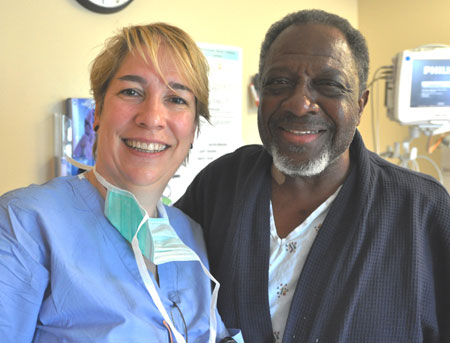
It was a heart transplant that saved Kaiser Permanente patient Stanley Crayton’s life in 2001, and just recently, Crayton may have helped save his sister’s life using his knowledge of 13 years worth of Kaiser Permanente high-quality post-transplant heart care. Crayton is one of Kaiser Permanente’s longest-surviving heart transplant patients, and his living knowledge came into play when he was called back to Chicago to say goodbye to his 56-year-old sister who was dying of congestive heart failure. But, she didn’t die.
“Stanley’s a true hero in my eyes,” says Kaiser Permanente Santa Clara’s Dr. Dana Weisshaar, who is the Chief of Transplant Services. “He’s taken our heart care model seriously, really advocated for his sister and she’s alive today.”
At 70-years-old, Crayton is a fit former Air Force officer who follows the Kaiser Permanente heart transplant care regimen closely. He takes his meds regularly. He tries to eat healthy. One part of the heart care regimen is a monthly Heart Failure/Heart Transplant support group at the KP Santa Clara hospital.
“Every month, second Tuesday at the lunch hour, I’m there,” says Crayton. “I learn a lot.”
“Stanley’s one of our regulars,” says Janet Stevenson, social worker in the KP Santa Clara Heart Transplant Program, and the support group director. “We’ve been having these meetings for 20 years now. It’s a time and place where those waiting for a new heart can learn what to expect from people like Stanley who already had a transplant. And transplant patients can share their concerns with other heart recipients, and doctors at the support group.”
Crayton did a lot of sharing and a lot of learning after at the support group meetings after his transplant. One thing he says he learned about is the latest technologies in treating congestive heart failure, including Left Ventricular Assist Devices (LVAD).
“There’s a lot of talk about LVAD’s,” he recalls.
“We’ve had many Kaiser Permanente heart failure patients at the support group who’ve gotten Left Ventricular Assist Devices,” says Stevenson. “These implanted pumps can be a life-saving bridge till a patient gets a new heart, or they can help keep someone alive for the longer term.”
Armed with that kind of knowledge, and the determination of a former military man, Crayton made the trip to Chicago to visit his dying sister at a suburban hospital.
“It was a nice, new hospital, and the doctors were good,” says Crayton. “But they just didn’t seem aware that there might be more that could be done for Pamela.”
Crayton advocated strongly for a possible LVAD for Pamela, and talked about how it could help. He said there could be a heart transplant in her future. He talked about life-saving medications. The doctors at the Chicago-suburb hospital were wide-eyed, says Crayton.
“They asked me, ‘How do you know all this?” Crayton laughs again, “Because I’ve been there, thanks to Kaiser.”
Crayton convinced the suburban physicians to transfer Pamela to a high-level university heart care hospital in downtown Chicago. There, Crayton, again, “wowed” the physicians and nurses with his KP-gained knowledge of heart failure treatment.
“I even gave them a little lecture on the importance of having back-up electricity for the LVAD in case of a black-out” says Crayton proudly.
Pamela was given an LVAD, which saved her life, but she wasn’t on it for long. She was placed on a transplant waiting list, and, just like her brother, got a new heart in Chicago after waiting only a week. It was almost 13 years-to-the-day that Crayton got his new heart.
“I’m doin’ great thanks to Kaiser (Permanente),” says Crayton, “and maybe in a way, Pamela is too.”





